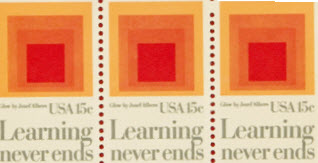¶ 1 Leave a comment on paragraph 1 0 O Mary found a little stamp,
A rarity, conceded.
In fact ’twas just the very one
Her dear old daddy needed.
It also chanced, this wondrous stamp,
That Mary did discover a
Rare Patriotic Cover.¶ 2 Leave a comment on paragraph 2 0 Now, Mary knowing that her dad
Liked stamps found in a garret,
Made haste to yank from envelope
Said stamp, as well as tear it.¶ 3 Leave a comment on paragraph 3 0 And thus she brought it to her dad
In ecstasy to show him,
But, from his look of seething rage,
She found she didn’t know him.¶ 4 Leave a comment on paragraph 4 0 A fortune he had won and lost
Through his beloved daughter,
Because to leave old stamp intact
He ne’er before had taught her.
And thou, O stamp-collecting sire,
Take this advice from me:
While in their youth, and ere too late,
Teach kids Philately.
G.M. McCracken, “Poor Mary,” 1933 ((G.M. McCracken, “Poor Mary,” Washington Post, August 27, 1933, sec. JP, 3.))
¶ 5 Leave a comment on paragraph 5 0 One might expect to find this jokingly didactic poem about the need to teach children about philately in a philatelic paper, yet this appeared in the Washington Post in 1933. By the 1930s, literacy in stamp collecting grew far beyond groups of philatelists and individual collectors, as stamp collecting permeated public culture. From the 1880s to the 1930s, Americans slowly learned to see postage stamps as something other than purely a sticker that represented pre-payment for mailing a letter. In the poem above, Mary noticed the stamp on the “Rare Patriotic Cover,” because she had been trained to identify it as something special and worth saving. Like Mary, Americans of all ages knew that people collected stamps for a variety of reasons. Starting in the late nineteenth century, American newspapers, magazines, and eventually radio exposed their audiences to articles, columns, and programs about stamp collecting, and circulated the idea collecting was educational for its participants. Philatelists shaped those discussions by publishing primers on how to start collecting, giving lectures, volunteering with after school groups, and by holding public exhibitions of their collections. Collectors first read imagery on stamps and created a set of practices around collecting and interpreting those objects.
¶ 6 Leave a comment on paragraph 6 0 Those practices of reading that included learning convention of stamp designs and interpreting the imagery, were adopted and used by different groups. Stamps’ accessibility in price and in visual appeal made them attractive pedagogical tools for teaching geography and empire, for encouraging religious evangelization, for encouraging orderly and structured play, and for engaging with the marketplace. These efforts to educate students and adults overlapped over a period of fifty years, as different generations of Americans learned about the practice and about meanings embedded in stamps.

Comments
0 Comments on the whole Page
Leave a comment on the whole Page
0 Comments on paragraph 1
Leave a comment on paragraph 1
0 Comments on paragraph 2
Leave a comment on paragraph 2
0 Comments on paragraph 3
Leave a comment on paragraph 3
0 Comments on paragraph 4
Leave a comment on paragraph 4
0 Comments on paragraph 5
Leave a comment on paragraph 5
0 Comments on paragraph 6
Leave a comment on paragraph 6